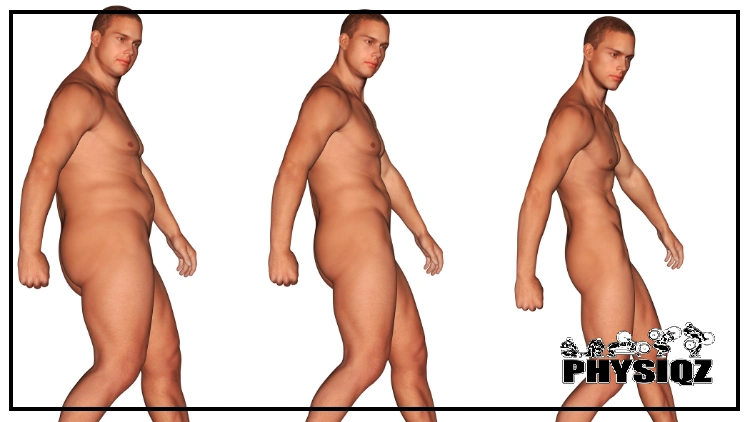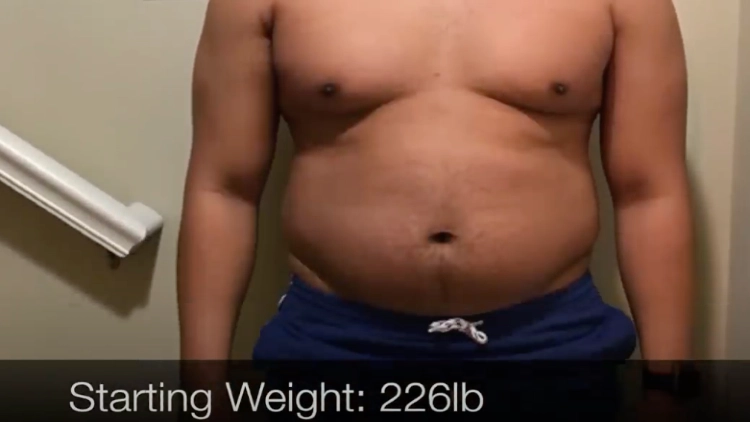
A keto weight loss timeline is a perfect way to gauge potential or current progress although everyone’s pace of weight loss will be difference due to many factors — some of which are inside your control, while others are not.1
In any case, insight about how long it takes to start losing weight on keto, a reasonable rate of weight loss on the keto diet, and how to speed up results can help you reach your ideal weight even sooner.
The bench marks and guidelines below provide a rough idea of what you experience at various milestones, and one man’s keto weight loss journey and pictures are divulged for inspiration.
The Relationship Between Keto & Weight Loss
The keto low carb diet focuses on consuming high (healthy) fats, moderate protein, and minimal carbohydrates, typically limiting daily net carbs to 20-50g. This approach is believed to support weight loss alongside overall health improvements. Specifically, those following keto guidelines should stick to about 70-80% of daily calories coming from healthy unsaturated fats, 10-20% from protein, and just 5-10% from carbs.
Although ketosis itself does not cause increased weight loss, the body can reap many health benefits from this adjustment and, in turn, can lead to increased well-being, energy, and fat-burning efficiency.
When carbs are restricted, the body must switch to burning fat stores instead and the ketogenic diet is perfect for this; with more fat being burned than glucose, body recomposition is likely as you decrease fat and are left with a higher percentage of muscle.
Aside from this change, the keto diet promotes healthier eating habits and a reliance on healthy fats and proteins rather than inflammatory grains, sugars, preservatives, artificial dyes, and highly processed foods.
Both healthy fats (monounsaturated and polyunsaturated fats) and proteins can provide heightened satiety–feeling fuller for longer–in contrast to carbs and processed foods.
A caloric deficit (consuming fewer calories than are expended) is what really counts in terms of weight loss but, as mentioned above, a low carb ketogenic diet can certainly aid in general health and indirectly help with weight loss.
For example, the ketogenic diet and lifestyle are likely to lower glycated hemoglobin or A1C–average blood sugar levels–and may even lead to type 2 diabetics being able to gradually taper their diabetes medications down.2
Another study done on health benefits of a low carb high fat diet not only supported the concept that ketosis can improve glycemic control and overall health, but also boosts cardiovascular health and even endocrinological disorders including polycystic ovary syndrome (PCOS).3 Further health benefits of the keto diet include aiding in weight regulation, glycemic control, and increasing HDL (healthy cholesterol) levels.4
How Soon Can You Expect To Start Losing Weight on Keto?
Even though everyone’s weight loss timeline in keto diet is different, we’ll still go over a general outlook and what to expect when starting keto. Keep in mind that when beginning the keto diet, many people rapidly lose water weight due to the body drastically adjusting its energy source and use.
This can cause extreme weight fluctuation especially in the first week–and may even be mistaken for drastic fat loss–but set realistic expectations going in, remember weight may plateau at times, and be consistent when you hit temporary roadblocks.
Keto Weight Loss Timeline (What To Expect When Starting Keto)
For beginners to the keto diet, it can be difficult to set challenging yet attainable goals or to know a rough keto progress timeline of weight loss.
We’ll outline what happens at various points throughout reaching, achieving, and maintaining ketosis, what you may feel at various stages, and what to expect along the way in hopes that you’ll feel better prepared for the journey ahead.
We’ll also share some insight and snippets of Pat’s story–a man who lost an impressive 57 lbs in about 6 months by combining clean eating, keto, and regular intense physical exercise.
Though we are only providing one example, keep in mind everyone’s pace will vary and that any weight loss and body recomposition results are to be celebrated no matter the rate.
Women can find inspiration in a realistic 6 month body transformation female for relevant examples, but it’s important to use these as motivation rather than comparing oneself to these outcomes. Always compare your progress to your past self rather than to others and keep your head up even on the days it feels most difficult. The results will be incredible if you see it through.
Keto Weight Loss Timeline: The First Week
The first week or two of adjusting to a ketogenic diet are often most difficult; it’s important to go into ketosis knowing it will be challenging but with realistic expectations to get you through the tough days.
You may experience fatigue, irritability, hunger, some water weight loss, and more fluctuations of keto weight loss in the first week; as your body makes major changes to burning fat and ketones rather than glucose. Symptoms of keto flu like keto night sweats and other temporary discomforts will soon subside, so stay motivated and focus on the bigger picture.
Pat’s Week One Review
Pat, pictured above, was 226 lbs when he began the keto diet and fairly active but less agile than he wanted to be. He was hoping to lose weight, build muscle, and improve overall health. Pat paired keto with regular physical exercise, working cardio and weight lifting into his routine to increase muscle as his body began burning fat for energy.

Source: PK Nutri from YouTube5
As you can see, Pat had to take breaks and struggled to get through a set of sprints without needing a breather but he took a brief break and got back to it. Pat also followed a strict keto diet with only 5% carb consumption and ate plenty of healthy fats and protein.

Source: PK Nutri from YouTube
1 Month on the Keto Diet
Keto one month progress will likely feel much better than week one did; by this time, your body will be more efficient at burning fat for energy use and keto flu symptoms should be over.
Your hunger and cravings should decrease as your body gets used to this new eating routine and the benefits of increased satiation. Insulin levels will also drop, further indicating that your body is in ketosis.
Around this time, you might notice feeling less bloated and more energized throughout the day. Replenish electrolytes, stay hydrated, and work physical activity, a regular sleep schedule, and other healthy habits into your routine.
Pat’s Keto One Month Progress
After a rigorous first month or so of getting serious about cardio, lifting, and eating a keto diet, you can see that Pat already had very distinct results. With energy and endurance building, the progress made already gave him motivation to continue. He stuck with his eating plan, and worked out daily doing sprints, jumping jacks, planks, free weights and machines to get more toned as his body burned fat.

Source: PK Nutri from YouTube
Pat added in crossfit workouts once a week and noted he was intermittently fasting, only eating between 2-8pm.
Keto Weight Loss Timeline: What To Expect After 6+ Months
Within the first couple of months it’s common for keto dieters to lose weight at an accelerated rate of 8-12 pounds or so monthly, but be mentally prepared for this to slow after the initial couple of months.
This doesn’t mean you’re doing anything wrong; the body simply has more drastic results at first and tends to settle into a slower, more consistent pace as you have less fat to lose.
You can expect significantly more energy than you had before starting keto because your body will become much more efficient and effective at utilizing fat stores and consumed fat. Activities that felt nearly impossible at first (like eating clean, avoiding processed foods, getting regular exercise) now feel second-nature since they’ve become healthy habits.
Pat’s 6 Month Transformation & Results
At 6+ months of ketosis, Pat’s timeline for keto weight loss ended as he achieved his goal weight. By comparing his before and after photos, it’s evident how well pairing exercise with keto worked. Within 6 months, Pat had an incredible transformation, dropping to 169 lbs for nearly 60 lbs of weight loss.

Source: PK Nutri from YouTube
Maintenance Phase of the Keto Progress Timeline
Although one’s keto weight loss timeline ends whenever they hit their goal weight, they can then begin the maintenance in which goals and calories may be adjusted accordingly. For example, a caloric deficit should be reassessed to determine how many daily calories will allow for maintenance instead of continued weight loss.
Many choose to focus on body recomposition and building muscle at this point, altering their workouts and eating habits accordingly. If you’re wondering how to distinguish between fat and loose skin, consider doing a simple pinch test or scheduling a DEXA scan to better plan your goals.
Regardless of your next step, be careful not to get lax with your eating habits and regain the weight you worked hard to lose. Above all, be sure to celebrate how far you’ve come and all you’ve achieved already.
Pat’s Maintenance Adjustments
Once Pat reached his goal, he set a new one: toning his muscle and lowering his body fat percentage. This photo really highlights the difference that body composition can make even when weight remains constant. Pat’s body fat percentage went from 28.3% when he’d begun to 10.4% during his maintenance and recomposition phase.

Source: PK Nutri from YouTube
What Is a Reasonable Rate of Weight Loss on the Keto Diet? How Fast Can You Lose Weight on Keto?
Though a weight loss timeline of keto diet varies from person to person, week by week we recommend striving for 1-2 lbs of fat loss or 1% of total body weight loss per week.
Attempting to surpass this rate or pushing oneself too aggressively is counterproductive and unsustainable. For those feeling frustrated and questioning why they are only losing a pound a week, it’s important to understand that this rate is actually very healthy and sustainable for long-term progress.
How Can Following Keto Guidelines Help With Losing Fat?
Following keto guidelines can aid in losing fat because the body is forced to switch from using glucose from carbs for energy to using ketones from fats instead. With no carbs to rely on for energy, the body will adjust and get more efficient at fat burning–so much so that you’ll start burning fat even when sitting or sleeping.
Since protein and healthy fats help you feel full, keto can decrease cravings and overeating too.
Tips To Speed Up Fat Burning on Keto
Those wondering if you can be in ketosis and still not lose weight might be surprised to learn that it’s possible—especially if you’re not getting enough sleep, consuming alcohol, or ingesting too much sugar. If your low carb diet results timeline is longer than you’d like, we’ll give some helpful tips to expedite fat loss.
First, ensure you’re staying hydrated; the reason drinking water aids in weight loss is mainly because it keeps the entire body running smoothly; when properly hydrated, the more efficiently the body will work. Water can boost metabolism, suppress appetite, aid in waste removal, regulate blood pressure, and boost brain function.6

Source: Fortune Vieyra via Unsplash7
Other tips include:
- Weekly Weigh-Ins
- Incorporate Fiber into Your Diet
- Get a Gym Membership
- Enlist an Accountability Partner
- Get Outside
- Use a Standing Desk
- Increase Daily Step Count
- Get Plenty of Rest
- Track Calories & Macros
- Ensure You’re in a Calorie Deficit
- Increase Your Heart Rate and Get Active
What To Be Cautious of on the Keto Diet
Keep in mind that giving up on weight loss isn’t an option, so we’ve compiled a list of precautions to follow while in ketosis to prevent burnout or hindered weight loss.
One factor that often goes unnoticed is the role of fiber–the relationship between fiber, digestion and health is very positive, with the two types of fiber playing their own roles in digestion. Insoluble fiber brings water to the intestines and increases bulk of waste to keep things moving, prevent constipation, and keep you regular. Alternatively, soluble fiber turns to a gel-like substance during digestion and aids in nutrient absorption and stabilizing blood glucose.8
Other things to be cautious of on keto are:
- Being Too Sedentary
- Belittling Yourself
- Comparing Your Progress to Others’
- Consuming Sugar, Alcohol, Artificial Preservatives, or Highly Processed Foods
- Eating Too Little
- Eating Foods High in Unhealthy Fats
- Exceeding Daily Carb Limit
- Failing to Track Macros & Calories
- Lacking Fiber
- Not Getting Proper Micronutrients or Phytonutrients
- Over-Consuming Protein
- Raising HDL Cholesterol
- Setting Unreasonable Goals
- Taking Too Many Cheat Days
- Trying to Lose Weight Too Rapidly

Source: Juliane Liebermann via Unsplash9
Be kind and patient with yourself and if you slip up, have a cheat day, or realize you were tracking something wrong, don’t be hard on yourself; simply learn and move forward with a better mindset, develop better eating patterns, and gradually integrate more and more healthy habits along the way.
By ensuring you’re eating plenty of healthy fats, the right proportion of protein, and limiting your carb intake, you can speed up fat loss results on the keto diet–especially if combined with exercise. Try tracking your calories, carbs, and creating your personal keto weight loss timeline as you go.
Frequently Asked Questions
How Much Weight Can I Expect To Lose Week by Week on Keto?
A recommended timeline of ketosis weight loss is to shoot for losing 1% of your total body weight weekly while on keto.
What if My Keto Weight Loss Timeline Is Longer Than Others?
No two people’s ketosis timeline is the same, as everyone has a different starting weight, activity level, goal weight, and many other factors. Your keto weight loss timeline should and will be different from others’ and that’s completely fine. Focus on making consistent progress, as reaching your goal is far more important than the pace.
What Are the Best Ways To Keep Motivation High While in Ketosis?
If you’re lacking motivation while on keto, try taking progress pictures throughout to see a visual of how far you’ve already come, take body measurements, keep a journal of how you’re feeling and how your energy levels change, or create your own version of a keto fat loss timeline.
References
1maschiffm. “Weight loss.” Canva. Accessed 22 April 2023. <https://www.canva.com/photos/MADAZB2_KZI-weight-loss/>
2McGaugh, E., & Barthel, B. (2022, February). A Review of Ketogenic Diet and Lifestyle. Missouri Medicine, 119(1), 84-88. <https://www.ncbi.nlm.nih.gov/pmc/articles/PMC9312449/>
3Nuwaylati, D., Eldakhakhny, B., Bima, A., Sakr, H., & Elsamanoudy, A. (2022, November 17). Low-Carbohydrate High-Fat Diet: A SWOC Analysis. Metabolites, 12(11), 1126. <https://www.ncbi.nlm.nih.gov/pmc/articles/PMC9695571/>
4Zhou, C., Wang, M., Liang, J., He, G., & Chen, N. (2022, August 22). Ketogenic Diet Benefits to Weight Loss, Glycemic Control, and Lipid Profiles in Overweight Patients with Type 2 Diabetes Mellitus: A Meta-Analysis of Randomized Controlled Trials. International Journal of Environmental Research and Public Health, 19(16), 10429. <https://www.ncbi.nlm.nih.gov/pmc/articles/PMC9408028/>
5PK Nutri. “Motivational 6 Month Body Transformation – Fat to Shredded.” YouTube, 5 September 2017. Accessed 22 April 2023. <https://www.youtube.com/watch?v=kMmsi9Vfhrs>
6Hub at Work. (2020, January 15). Yes, drinking more water may help you lose weight. Johns Hopkins University. Retrieved March 13, 2023, from <https://hub.jhu.edu/at-work/2020/01/15/focus-on-wellness-drinking-more-water/>
7Fortune Vieyra. “man in white tank top and gray shorts sitting on blue floor photo – Free Fitness Image on Unsplash.” Unsplash, 26 March 2021. Accessed 22 April 2023. <https://unsplash.com/photos/jD4MtXnsJ6w>
8Gannett Health Services. (2012, November). Fiber, Digestion and Health. Cornell University. Retrieved March 13, 2023, from <https://health.cornell.edu/sites/health/files/pdf-library/fiber-digestion-health.pdf>
9Juliane Liebermann. “woman in blue denim jeans and black jacket walking with woman in green jacket photo – Free Children Image on Unsplash.” Unsplash, 27 November 2020. Accessed 22 April 2023. <https://unsplash.com/photos/Pw7i-YVg5uM>